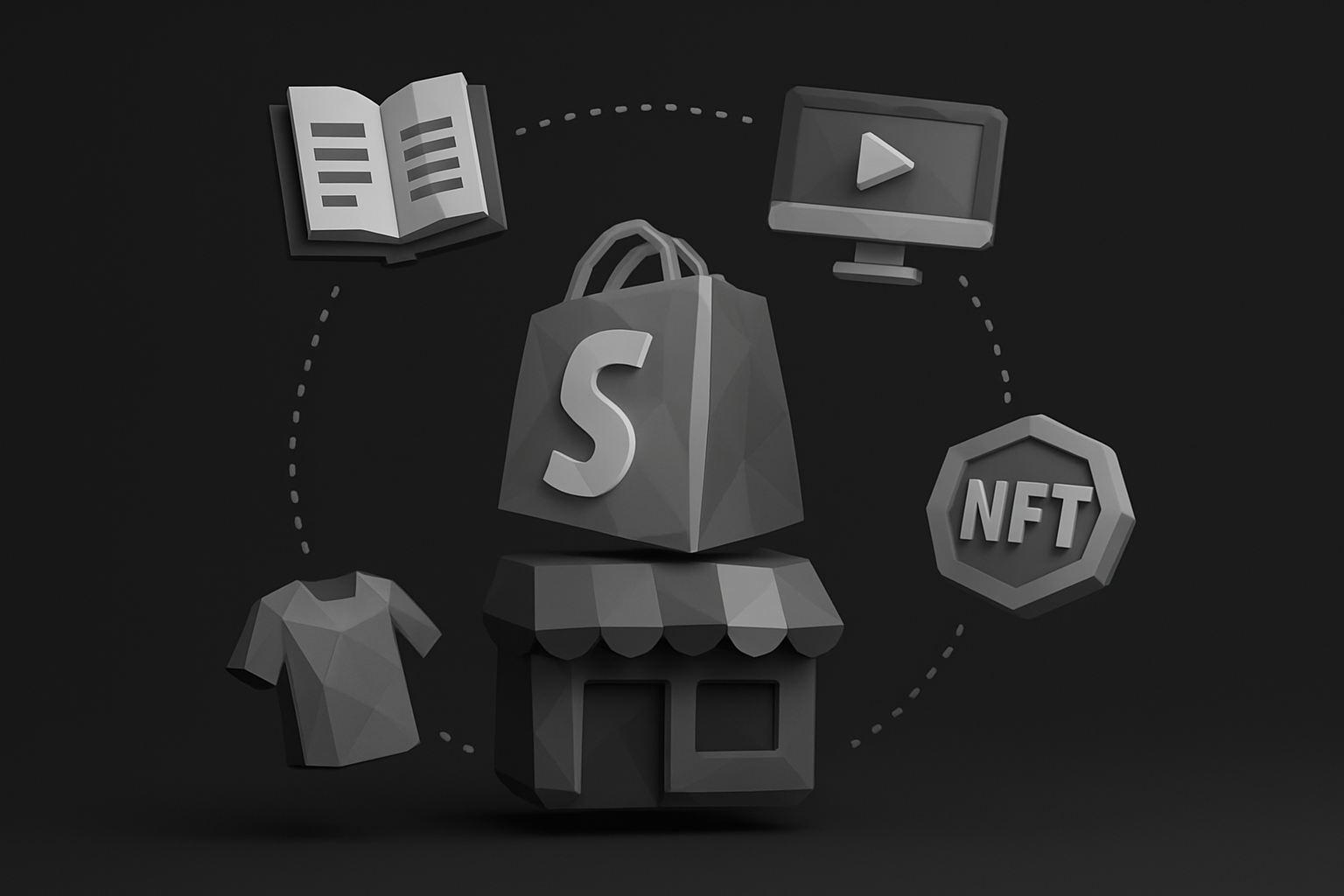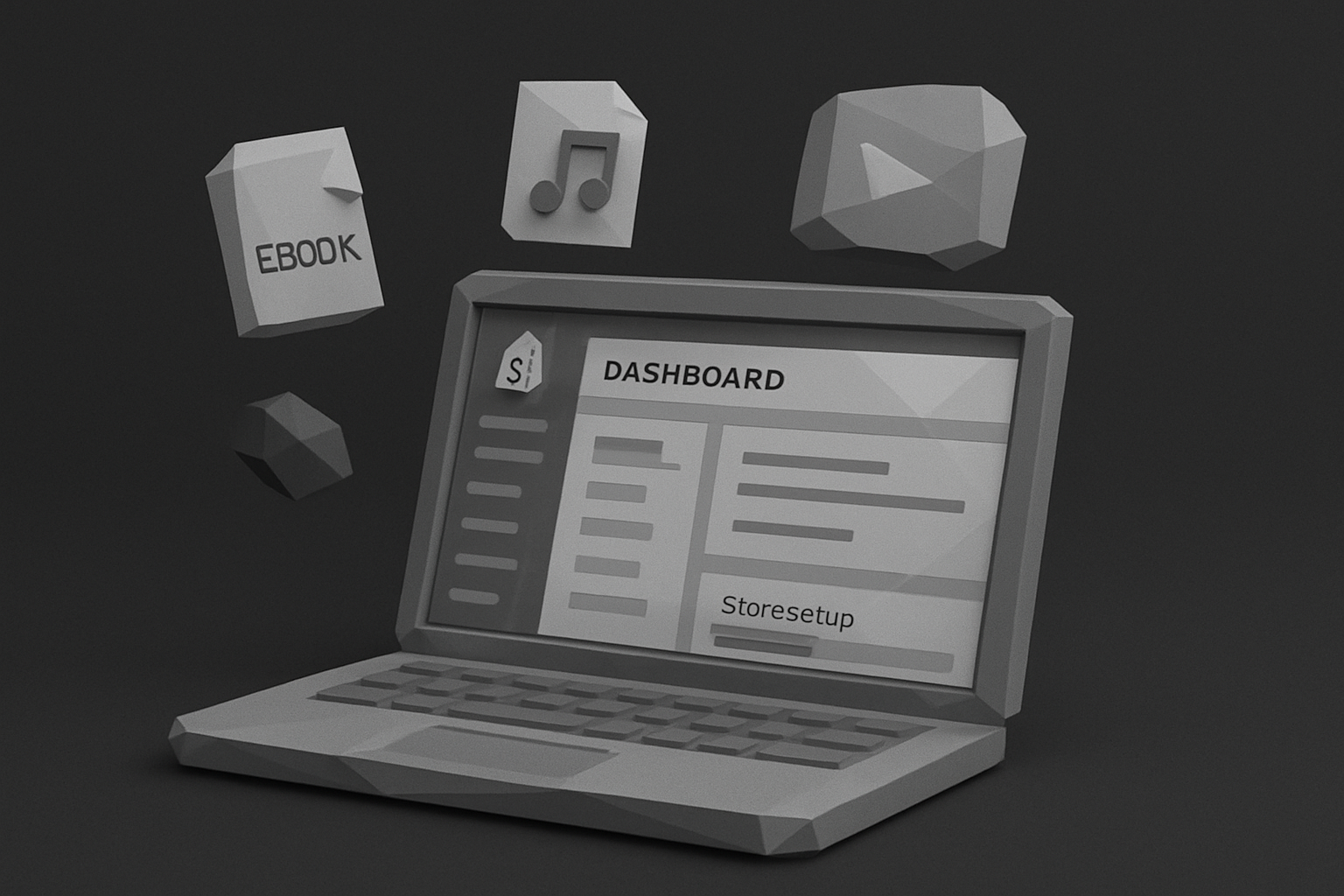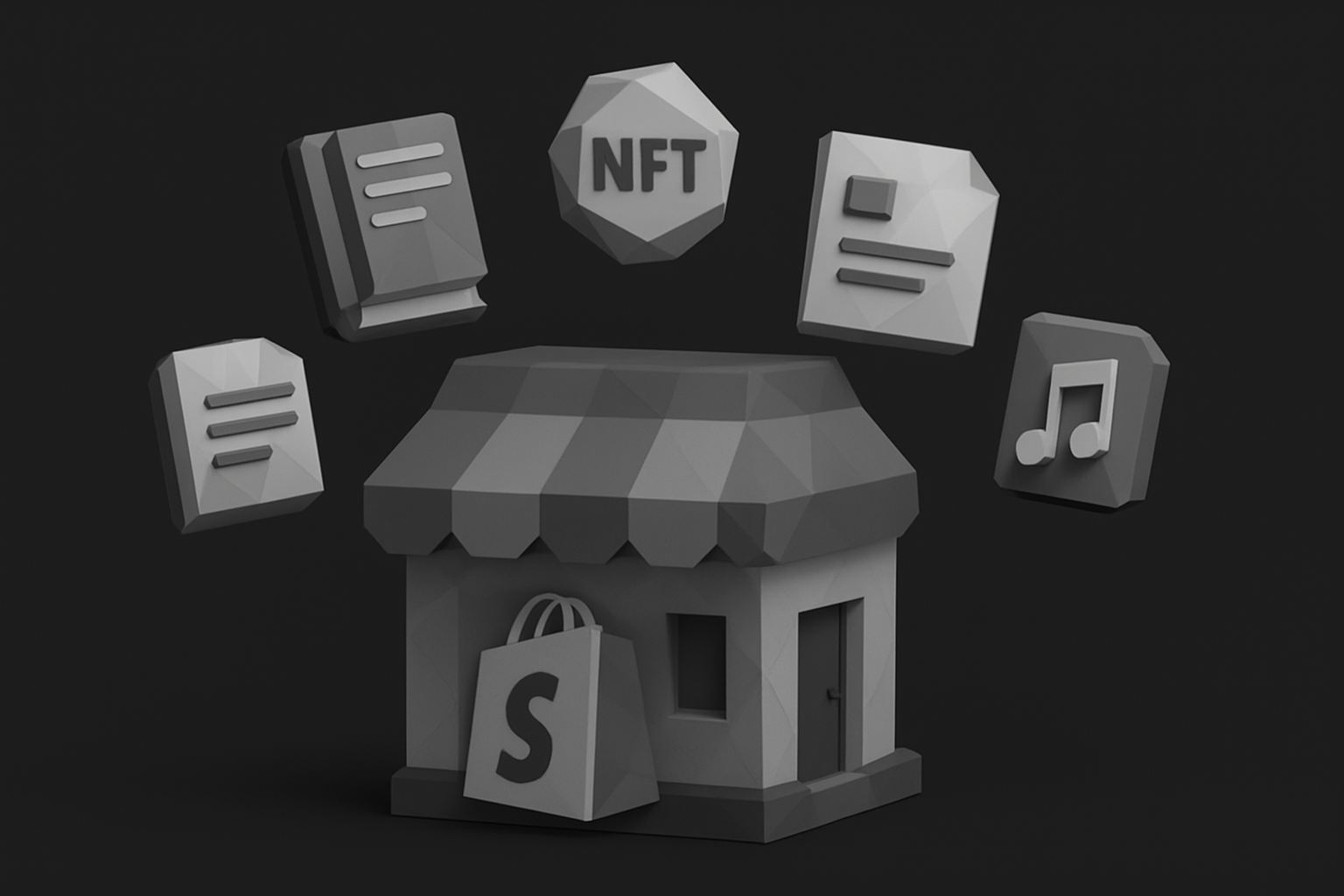Ready to unlock the future of passive income? Selling shopify digital products in 2025 puts you at the center of booming markets—think e-learning projected at $848 billion by 2030, and NFTs surging to $609 million in 2025. Shopify’s platform now makes it easier than ever to launch, automate, and scale your digital business globally. Imagine low overhead, high profit margins, and total location freedom. This guide delivers actionable strategies, platform walkthroughs, and expert tips so you can confidently start selling shopify digital products. We’ll cover product types, store setup, essential tools, marketing tactics, and the hottest trends for 2025.
Understanding Digital Products and Market Trends in 2025
Digital products have transformed how entrepreneurs build businesses online. In 2025, shopify digital products span far beyond ebooks and music—they include interactive courses, AI-generated templates, blockchain-authenticated art, and even virtual goods for metaverse platforms. This evolution means sellers can create and deliver experiences that are more immersive, personalized, and valuable than ever before.
Today’s digital products are not just static downloads. Subscription-based content, blockchain-verified assets like NFTs, and AI-powered resources are reshaping the landscape. For example, downloadable coloring pages and productivity templates powered by AI are rising in popularity, while digital art authenticated on the blockchain ensures uniqueness and ownership. No inventory or shipping means instant delivery and endless scalability, giving creators unprecedented freedom.

Defining Digital Products and Their Evolution
Digital products are intangible goods delivered electronically—think ebooks, online courses, software, music, templates, and digital art. By 2025, the definition expands to include interactive experiences, subscription content, blockchain-based assets (like NFTs), and AI-generated resources. New formats emerge, such as virtual goods for metaverse platforms and smart templates that adapt to user input. These innovations let creators offer more value and differentiation with shopify digital products, all without physical stock or logistics.
Recent trends highlight the surge in unique formats: downloadable coloring pages for mindfulness, AI-crafted business templates, and blockchain-authenticated digital art that guarantees authenticity. These examples show how digital products can be versatile, scalable, and tailored to evolving consumer needs.
Why Sell Digital Products? Key Benefits and Challenges
Selling shopify digital products offers clear advantages. There’s no need to manage inventory, shipping, or supply chains—overhead stays low and profit margins remain high. Automation tools enable instant delivery, so you can sell worldwide with minimal effort. The environmental impact is smaller too, since nothing physical is produced or shipped.
However, challenges do exist. The market is crowded, with many free alternatives available. Piracy and content theft are real concerns, so product differentiation and security are crucial. Staying ahead means offering unique value and protecting your assets.
The opportunity is massive: the e-learning market is projected to reach $848.1 billion by 2030, while the NFT sector is expected to hit $609 million in 2025. These figures signal strong, sustained demand for digital products.
Shopify’s Place in the Digital Product Ecosystem
Shopify stands out as a powerful platform for selling digital products. Unlike marketplaces that may take up to 50% commission, Shopify lets you control branding, pricing, and customer experience. Its robust app ecosystem—featuring tools like Digital Downloads and Downloadable Digital Assets (DDA)—streamlines delivery, automates fulfillment, and enhances security.
Here’s a quick comparison:
| Platform | Commission | Branding Control | Automation | Security Tools |
|---|---|---|---|---|
| Shopify | 0-2% | Full | Strong | Advanced |
| Marketplaces | 10-50% | Limited | Varies | Basic |
With shopify digital products, you can easily attach files to product listings, automate email delivery, and track downloads. Apps like DDA offer features like file protection, download limits, and analytics, helping you ensure a smooth and secure customer experience from start to finish.
Step-by-Step: Setting Up Your Shopify Store for Digital Products
Ready to turn your expertise or creativity into income? Setting up a store for shopify digital products is easier than ever in 2025. Let’s break down the process step by step, so you can launch confidently and deliver value to customers worldwide. If you want an in-depth checklist, check out this Digital products step-by-step guide for extra support.

1. Signing Up and Configuring Your Store
Kick off your journey by signing up for a Shopify account—new users get a free trial, so there’s no upfront risk. During onboarding, select “Digital products” as your main product type. This helps Shopify tailor the experience for your needs.
Next, set your store’s location. This ensures accurate tax calculations for digital goods, which can vary by region. Choose a theme that’s clean, fast, and optimized for conversions—think minimal layouts that highlight your shopify digital products front and center.
Tip: Shopify’s onboarding flow guides you through each of these steps. Take your time to explore theme previews and settings before moving forward.
2. Installing Essential Digital Product Apps
Out-of-the-box, Shopify supports digital sales, but specialized apps unlock advanced features. Start with the Shopify Digital Downloads app for basic file delivery. If you need stronger security or automation, consider Downloadable Digital Assets (DDA).
Benefits of DDA:
- File protection and download limits
- Customizable email delivery
- Analytics for tracking downloads
Install your chosen app from the Shopify App Store. After installation, configure settings like storage limits, file types, and delivery methods. DDA’s free plan covers basic needs—1GB storage and one file per product—while premium plans add features like thank-you page downloads and enhanced security.
3. Adding and Managing Digital Products
Uploading your shopify digital products is simple. Supported formats include PDFs, MP3s, ZIP files, and more. Organize files with clear naming conventions, especially if you offer bundles or multiple versions.
Create product listings with compelling titles and descriptions. Highlight the benefits and unique features of your digital offers. Set your pricing—consider bundles or tiered options to maximize value.
Don’t forget to disable inventory tracking and shipping for digital products. Attach files directly to listings using your digital product app. Here’s a quick example for DDA users:
Product Settings > Attach File > Select from Library > Save
Preview listings to ensure everything looks polished before going live.
4. Setting Up Email and Customer Communication
Instant delivery is key for customer satisfaction with shopify digital products. Configure transactional emails so buyers receive download links immediately after purchase.
For better deliverability, connect your store to an SMTP provider like SendLayer. This helps your emails land in inboxes (not spam), especially with Gmail and Outlook tightening requirements in 2025.
Customize your email templates—add your logo, adjust messaging, and include helpful instructions. DDA integrates smoothly with SendLayer for reliable, branded delivery. Test your workflow by making a test purchase and reviewing the customer email experience.
5. Launching Your Store and Testing the Customer Journey
Before launching, walk through your full customer journey. Preview your storefront, add a product to cart, and complete a test checkout. Confirm that instant delivery works and files are accessible.
If issues arise, check app settings, file attachments, and email configurations. Reliable support is essential—respond quickly to customer questions and gather feedback for improvements.
Launching your shopify digital products store is just the beginning. With these steps, you’ll deliver a seamless experience and build trust from day one.
Essential Tools, Apps, and Integrations for Digital Product Sellers
Whether you’re just starting out or scaling up, the right tools can make all the difference in your shopify digital products journey. From seamless delivery to airtight security, choosing the best apps and integrations ensures you offer a smooth, professional customer experience.

Must-Have Shopify Apps for Digital Products
Selecting the right app is the backbone of selling shopify digital products. Shopify provides a native Digital Downloads app for basic needs, but advanced sellers often upgrade to robust solutions like Downloadable Digital Assets (DDA), Sky Pilot, SendOwl, or FetchApp.
Here’s a quick comparison to help you decide:
| App Name | Key Features | Pricing | Pros | Cons |
|---|---|---|---|---|
| Digital Downloads | Basic delivery, free, integrates with Shopify | Free | Easy setup, no cost | Limited features, basic email |
| DDA (Downloadable DA) | File protection, expiry, analytics, branding | Free/Paid | Security, automation, scale | Storage limits on free plan |
| Sky Pilot | Video streaming, memberships | Paid | Great for video/courses | No free plan |
| SendOwl | License keys, automation, upsells | Paid | Versatile, robust features | Can be complex to set up |
| FetchApp | Bulk delivery, cloud storage | Paid | Handles large catalogs | Outdated interface |
When evaluating, consider your product type, security needs, and growth plans. For most shopify digital products, DDA strikes a balance between simplicity and power—especially if you want detailed analytics or download restrictions.
Email, Analytics, and Automation Integrations
To maximize sales and manage shopify digital products efficiently, integrate email marketing, analytics, and automation tools. Platforms like Klaviyo and Shopify Email help you nurture leads, send automated product access emails, and recover abandoned carts.
For analytics, combine Shopify’s built-in dashboard with Google Analytics for deep insights. Many digital product apps—like DDA and SendOwl—offer their own reporting, so you can track downloads, revenue, and customer behavior in one place.
Automation is a game-changer. Use Shopify Flow to trigger follow-up emails, upsell offers, or even automate license delivery. Want to dig deeper into strategies and workflows? Check out this Building digital products blog for practical tips on streamlining operations and scaling faster.
Security, Piracy Protection, and File Management
Protecting your shopify digital products is crucial. Leading apps offer download limits, file expiry, and even watermarking to deter unauthorized sharing. Always use strong, unique file names and organize assets in secure cloud storage.
For licensing or unique codes, SendOwl and DDA support automated key generation. Regularly backup your files and monitor download logs to spot suspicious activity.
Don’t forget—clear product licensing terms and customer support build trust and reduce disputes. With the right tools, you’ll safeguard your digital assets and keep your business running smoothly.
Top Digital Product Ideas and Niches for Shopify in 2025
Looking for the most profitable shopify digital products to sell in 2025? The landscape is richer and more diverse than ever, making it possible for entrepreneurs to carve out unique niches and tap into emerging trends. Whether you’re a creator, educator, or designer, there’s a shopify digital products opportunity waiting for you.

High-Demand Digital Product Categories
The appetite for shopify digital products is surging across multiple categories. Sellers are thriving by offering:
- Online Courses & Workshops: Interactive video lessons, quizzes, and certification programs appeal to lifelong learners.
- Ebooks & Guides: Deep-dive content bundles or niche expertise packaged for instant download.
- Printables: Planners, coloring pages, wall art, and educational worksheets for home use.
- Templates & Tools: Website templates, productivity systems, and design resources.
- Licensed Content: Stock photos, royalty-free music, and vector graphics.
- Premium Content Libraries: Memberships and exclusive resource vaults.
- AI-Enhanced Products: Personalized tools, chatbots, and AI-generated art.
If you need inspiration or want more examples of shopify digital products, check out these digital product ideas for Shopify to jumpstart your creative process.
Trends and Opportunities for 2025
The digital product landscape is evolving quickly, and shopify digital products are at the forefront of these shifts. Some of the most exciting trends include:
- Subscriptions: Recurring revenue through gated content, member-only resources, or ongoing updates.
- Blockchain & NFTs: Digital ownership, verified authenticity, resale rights, and creator royalties are changing how value is delivered.
- Virtual Goods & Metaverse Assets: Sell avatars, digital wearables, and in-game items for metaverse platforms.
- AR/VR & Gamified Experiences: Immersive learning modules, interactive art, and virtual events.
- AI-Driven Content: Dynamic templates, personalized recommendations, and smart digital products.
Statistics show explosive growth: NFTs are expected to reach $609 million in 2025, while e-learning is projected to soar to $848 billion by 2030. These trends signal that shopify digital products are only gaining momentum, opening new doors for innovation and profit.
Examples of Successful Shopify Digital Product Stores
Many entrepreneurs have already built thriving businesses with shopify digital products by focusing on differentiation, branding, and community. Consider these standout examples:
- How to Cake It: Blends digital cookbooks and baking guides with interactive online courses, building a devoted audience of home bakers.
- Caravan: Offers downloadable coloring posters and educational printables, catering to families and teachers seeking creative resources.
- RetroSupply Co.: Sells design tools, brushes, and asset bundles, targeting professional creatives and hobbyists alike.
Each of these stores excels by providing unique value, cultivating loyal communities, and leveraging the flexibility of shopify digital products. Their success stories highlight the power of clear branding, quality content, and ongoing engagement.
As you plan your shopify digital products journey, remember that the most successful sellers are those who adapt to trends, understand their audience, and keep innovating. The digital marketplace is wide open—now’s your time to stand out.
Marketing and Selling Digital Products on Shopify: Strategies for 2025
Unlocking the full potential of shopify digital products in 2025 means mastering both marketing and sales. The competition is fierce, but with the right strategies, your digital storefront can stand out and thrive. Let’s break down the key tactics to grow your brand, boost conversions, and future-proof your business.
Building Your Brand and Audience
Success with shopify digital products starts with a strong brand and a loyal audience. Begin by identifying a profitable niche—think digital education, design assets, or productivity templates. Your brand positioning should communicate clear value and solve a specific problem.
Content marketing is your secret weapon. Blog posts, SEO, and lead magnets (like free mini-guides or sample files) drive organic traffic and establish trust. For example, offering free printables or templates is a proven way to grow your email list and nurture future customers.
Email marketing is essential. Use every opportunity—pop-ups, checkout, and lead magnets—to invite visitors to join your list. Then follow up with valuable content, exclusive offers, and product launches.
Social proof builds credibility. Encourage reviews, collect testimonials, and showcase user-generated content. Take inspiration from brands that grew massive lists using freebies—like Big Life Journal, which built a 200,000+ email list with free downloads. And remember, the digital education market alone is projected to reach USD 89.0 Billion by 2030, making this a prime time to grow your audience.
Multi-Channel Selling and Promotion
Don’t limit your shopify digital products to your own storefront. Expand your reach by exploring third-party marketplaces like Etsy or Gumroad, and tap into social media storefronts such as Instagram Shopping, Facebook Shops, and TikTok Shop.
Consider influencer partnerships and affiliate programs to leverage existing audiences. Collaborate with creators in your niche who can authentically promote your products.
Here’s a quick comparison of selling options:
| Channel | Pros | Cons |
|---|---|---|
| Shopify Store | Full control, lower fees | Requires traffic generation |
| Third-Party Marketplace | Built-in audience | Higher commissions (up to 50%) |
| Social Media Storefronts | Visual discovery, direct sales | Algorithm dependence |
While third-party platforms offer exposure, they often come with steep fees and less control over your brand. Owning your customer relationship through your Shopify store is key to building long-term value.
Pricing, Offers, and Conversion Optimization
Pricing shopify digital products effectively is both art and science. Research your competitors and consider offering bundles or tiered pricing to maximize value. Subscription models can provide recurring revenue and increase customer lifetime value.
Conversion optimization is ongoing. Upsell related products at checkout, cross-sell complementary items, and use limited-time discounts for urgency. A/B test your product pages and checkout flows to see what drives the highest conversions.
For example, launching with early-bird pricing or exclusive bundles can create buzz and reward your first customers. The goal is to make every store visit count.
Legal Considerations and Compliance
Selling shopify digital products globally means navigating taxes, copyright, and privacy regulations. Shopify’s built-in tax tools can help automate VAT and sales tax calculation, but always double-check local requirements.
Protect your intellectual property by clearly stating licensing terms and usage rights. For digital goods, watermarking or license keys can add extra security.
Don’t neglect privacy. Ensure your store complies with GDPR and other data regulations. Be transparent about data collection and give customers control over their information.
Measuring Success and Scaling Up
To scale your shopify digital products business, track key performance indicators like sales, downloads, conversion rates, and customer retention. Analytics tools—Shopify Analytics, Google Analytics, and app-specific reports—help you spot trends and double down on best-sellers.
Scaling is about working smarter, not just harder. Expand your product line, launch memberships, or automate fulfillment. Embrace the create once, sell forever strategy to maximize your passive income potential. Each digital product becomes a long-term asset, generating revenue with minimal ongoing effort.
Stay agile, keep learning, and experiment with new marketing tactics to stay ahead in the fast-evolving digital landscape.
Future-Proofing Your Digital Product Business on Shopify
Staying ahead in the world of shopify digital products means future-proofing your business as technology, consumer expectations, and the digital landscape evolve. Let’s explore practical strategies to keep your store thriving for years to come.
Adapting to Evolving Technologies and Consumer Preferences
The shopify digital products market is constantly shifting as new technologies emerge. AI-powered personalization, automated customer support, and smart recommendations are becoming standard. Blockchain is revolutionizing digital ownership, enabling creators to offer verified, royalty-enabled assets like NFTs.
Looking ahead, AR/VR experiences and metaverse platforms will unlock new digital sales channels. Staying informed about trends—such as the rapid growth of NFTs, with the NFT market expected to reach $2.19 billion by 2032—helps ensure your business adapts to what customers want next.
Building a Sustainable, Passive Income Stream
Building a resilient shopify digital products business is about more than just launching a store. The “create once, sell forever” model lets you maximize ROI by selling the same digital asset to countless customers worldwide.
To keep your income growing, regularly update and repurpose your products. For example, bundle older ebooks into new collections or add fresh templates to your library. Foster a community around your brand—loyal customers are more likely to become advocates, offer feedback, and help spread the word about your latest launches.
Staying Ahead of the Competition in 2025
With shopify digital products, staying competitive means keeping your finger on the pulse of industry trends. Monitor emerging product formats, join digital seller communities, and schedule time for ongoing learning.
Experiment with new marketing tactics—like launching early-bird offers, running A/B tests on product pages, or piloting new content types. Attend webinars or read expert blogs to stay current. The most successful sellers adapt quickly, embracing change rather than fearing it.
Resources and Next Steps
Ready to strengthen your shopify digital products business? Start with Shopify Academy for platform-specific training, then explore expert podcasts, digital product forums, and curated blogs for fresh ideas.
Remember: you don’t need to launch everything at once. Begin small, iterate based on customer feedback, and scale confidently as you learn. The future of digital selling on Shopify belongs to those who stay curious, connected, and proactive.
Now that you’ve got the blueprint for launching and scaling your digital product business on Shopify in 2025, it’s time to take your first real step. Imagine turning your knowledge into self-sustaining products, reaching customers around the world, and building income that grows while you sleep. At CreateSell, we’re here to walk with you from idea to launch—whether you’re brand new or ready to level up. If you’re excited to start building your own digital product empire, let’s do it together—Get Started.